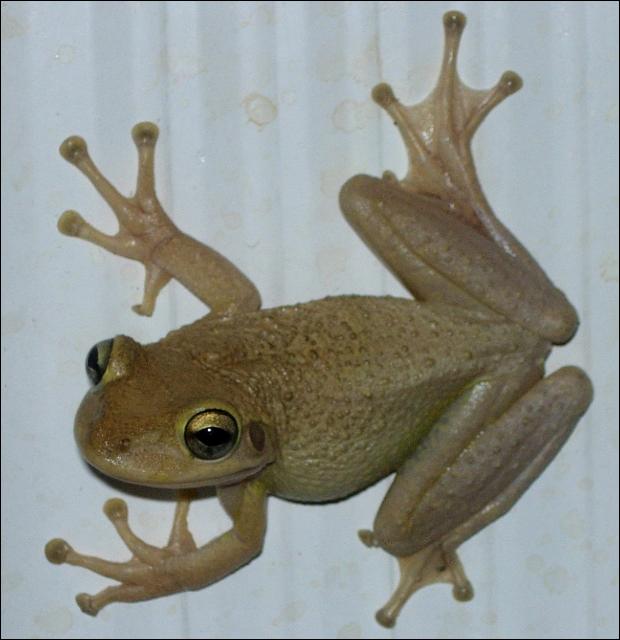
by Rick O'Connor | Mar 10, 2018
As we come to the end of National Invasive Species Awareness Week (NISAW), I need to educate everyone on a potential invasive threat, a classic Early Detection Rapid Response (EDRR) species – the Cuban Treefrog.
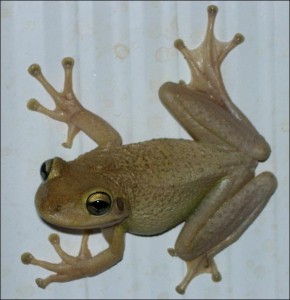
is this a Cuban Tree Frog? Do I have to rely on DNA barconding to know for sure – before I decide to euthanize it? Could I be making a mistake?
Image by Dr. Steve A Johnson 2005.
This treefrog was first introduced into to south Florida in the 1920’s. Like lionfish, it quickly became established and began its slow dispersal northward. It is a large predatory frog (reaching about 5”) which began to consume native treefrogs, reducing their populations wherever they were found. In addition to consuming native frogs, Cuban Treefrogs eat snails, millipedes, spiders, and many other small creatures. They can produce a call that is somewhat annoying to many residents where it is found. It is currently listed as established as far north as Gainesville FL.
A few years ago, I received a call from a resident near Big Lagoon in southwest Escambia County. They had just purchased plants from a local chain store to plant in their yard the following day. They had left the plants on the front porch that night and, at some point, noticed this large treefrog on their front door. They wanted to know if this was a non-native frog. It was – it was the Cuban Treefrog. The animal was collected and sent to the University of Florida.
This is a common method of transporting this frog north. They attach to ornamental plants grown in nurseries in south Florida. The plants are loaded on trucks and shipped to the panhandle and locations north and west. There are probably numerous species hitching rides this way, including the Cuban Anole (an invasive lizard). Lucky for us, in many cases these tropical problem species cannot tolerate our cold winters – this could also be said for some of the invasive plants. However, in recent years, the winters have been milder and some of these species are surviving. Most of us know and understand the impact lionfish have had on local small reef fish; no one is interested in another “lionfish problem” in the panhandle.
About a year ago, a second Cuban Treefrog was reported in Crestview.
Early this year I attended an amphibian/reptile conference in north Georgia. There was a presentation given by a scientist from the U.S. Geological Survey in Lafayette LA. He had a call from the Audubon Zoo in New Orleans about a strange frog they had been finding. They had recently purchased palm trees from south Florida for the elephant exhibit. The caretakers of the exhibit began to see strange frogs and reported it. When USGS arrived, they meandered through the park searching. They stopped by the public bathroom to look (a place I have found them in south Florida myself). They happen to pass an electric panel outside the restroom and decided to take a peak – 13 Cuban Treefrogs were within.
They began an exhaustive search and found CTFs everywhere. Most had moved into a public park between the zoo and the river called Riverview. I cannot remember how many they had found but it was in the hundreds, the animals were beginning to establish themselves in this area of New Orleans. USGS is currently working on the problem.
Just a few weeks ago, a Cuban Treefrog was found on Davenport Bayou off Bayou Grande.
There are many reports of single, individual CTFs across the northern Gulf coast, but none were established populations. However, as reports increase we should be looking for these animals and try to keep them under control before they do. No more “lionfish problems”.
How do we do this?
The following link provides information about the frog, how to identify it, how to set traps to determine if the animal is in your neighborhood, and what to do if you do find one. I would include reporting the finding on www.EDDMapS.org. I also recommend as you purchase plants for this spring’s landscaping projects, check the plants carefully for any hitchhikers. This “early detection” method is the most effective way to battle the movement of invasive species.
If you have questions about Cuban Treefrogs, let me know.
Johnson, S.A. 2017. The Cuban Treefrog (Osteopilus septentrionalis) in Florida. University of Florida Extension Electronic Data Information Source (EDIS) document WEC218.
http://edis.ifas.ufl.edu/uw259.
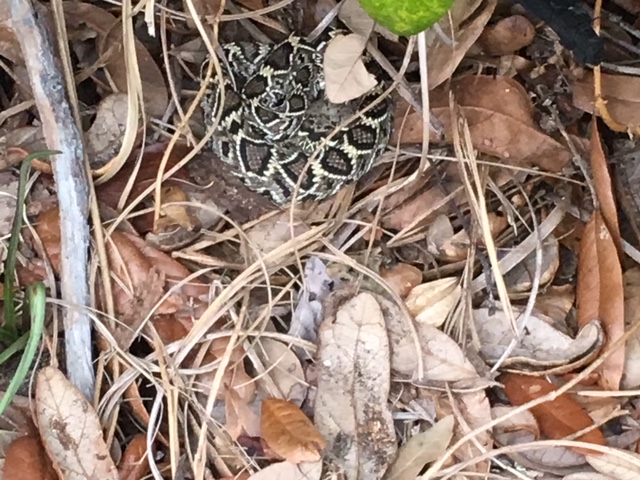
by Rick O'Connor | Mar 9, 2018
Most people know that snakes are ectothermic and the environment is what regulates their body temperature. However, many do not know that they like to maintain their temperature close to 98 F like us. To do this they must move to locations where they can either warm (like basking in the sun or lying on warm asphalt) or cool (like under rocks or logs). Unlike us, their temperature can rise to above 100 F or down close to 30 F with few health problems.
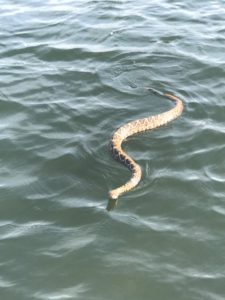
Eastern Diamondback Rattlesnake swimming across the Intracoastal Waterway near Pensacola Beach.
Photo: Andy Barnes
When environmental temperatures become colder, their heart and breathing rates slow significantly. Their blood oxygen levels decrease, and they become very slow and sluggish – a condition we call torpor. There are some advantages to this, such as not having to hunt for food for several weeks or months, but when the air temperatures begin to climb they become more active… Moreover, their hungry.
In the last two weeks, I have had numerous reports of snakes moving around in yards. There have been three records of diamondback rattlesnakes in the Pensacola Beach area alone.
Should I be concerned about doing outdoor activities?
No, not really – but you should be aware. As it warms, snakes will become more active early in the morning and late in the evening. Pit vipers, like rattlesnakes and cottonmouths, actually prefer hunting at night. However, when the temperatures are cool enough for mid-day movement, they will. Food and reproduction (for some species) are on their mind this time of year.
Stay on the trails – snakes typically do not like to be in the open because of predators but they do have to bask to increase their body metabolism; so they may be along the edge. If I am hiking, I tend to look down along the trail when walking. If I want to observe something in the trees, I stop.
These snake movements happen every year, and very people have problems, but with the recent increase in encounters it is could to be aware. I actually think snakes are pretty cool. I enjoy seeing them, especially ones that are not viewed very often like coral snakes and rattlesnakes. You should still go out and enjoy the Pensacola Bay area. It is a great time of year to do it.
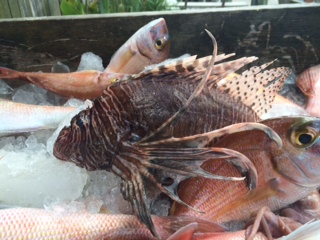
by Rick O'Connor | Feb 28, 2018
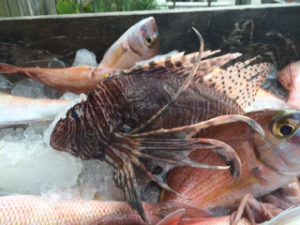
Lionfish caught on rod and reel. Photo Credit: Alison Rogers
Since the first lionfish was spotted off Pensacola in 2010, panhandle organizations have been busy trying to control the spread of this invasive species. The story is well known to many… the lionfish is a voracious predator, consuming at least 70 different species of small reef fish, including vermillion snapper. They reproduce frequently, producing an average of 25,000 eggs/female every four days – and they breed during most of the year. The densities of these fish on our nearshore and offshore reefs are some of the highest in the South Atlantic region, and they prefer artificial reefs to natural bottom. We know they have spread across the northern Gulf to include all five Gulf states and are found in Mexican waters.
We also know that the primary method of removal is still spearfishing. The state of Florida has an open season on them and provides a program to assist local divers with selling their harvest. There are several rodeo tournaments along the Gulf coast and some traditional fishing tournaments have created a category for them. Education programs about the problem continue and some restaurants have offered them when they can get them.
So how are things going?
Are we on top of controlling the lionfish?
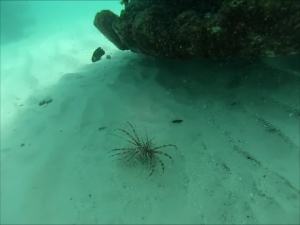
Lionfish at Pensacola Beach Snorkel Reef. Photo Credit: Robert Turpin
Anecdotal reports suggest we have made some impact. Local divers in the Pensacola area report that the shallower public reefs frequented by local divers and dive charters have indicated they are getting harder to find. There have been some tour trips, taking out of town residents diving for lionfish, where they have had to really search to find them. This is certainly encouraging and a numerical assessment of this is needed. However, there are also reports of charter fishing boats catching them on hook and line in deeper waters. They are not catching many, but they do occasionally grab them. When they do, it is usually on live bait and in deep water, 200 feet or so. Local divers seem to agree with this. They too find more lionfish, and some large ones, at depth – too deep to take a typical dive charter trip to remove.
Recent research has shown that lionfish are able, at least in the northern Gulf of Mexico, to swim greater distances than once thought to re-colonize reefs that have been cleaned. One study showed that selected artificial reefs, which were completely cleaned of lionfish, had restored lionfish populations, both young and old fish, within a year. This same study suggests that to keep lionfish at relatively low-density (about 5 lionfish/100 m 2) reefs would need to be cleaned every two months.
Several lionfish derbies occur along the Florida panhandle, but not at the frequency that may be needed to control re-colonization of shallower reefs by lionfish from deeper ones.
Can we increase the number of derbies?
Sure… but those who work on these derbies know the time and financial commitment required to put one on. It could happen that the number of local derbies would increase but we may have to think of other means of controlling lionfish.
One idea is to increase the number who harvest commercially. To do so a diver would need to acquire a saltwater products license from the Florida Fish and Wildlife Conservation Commission (FWC). On their website, they provide the application and a list of approved buyers for the diver to contact. http://www.myfwc.com/Lionfish.
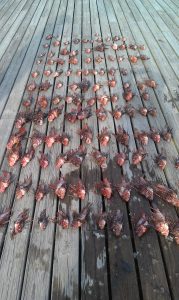
Harvested lionfish. Photo Credit: Bryan Clark
One drawback to the commercial idea is the price. Currently divers require a high price for their catch in order to cover cost and show a profit. These high prices equate to high prices at local restaurants, higher than the public may be willing to pay. One unpublished study shows that some locals are willing to pay more for a lionfish dinner if they know it is helping the environment. Many seafood lovers understand the high cost of lobster, but have not placed lionfish in the same category and are not as willing to pay higher prices; this may have to change. Research continues on developing a lionfish trap that has low by-catch rates. If an effective trap is developed, they could be deployed from vessels, which would not require diving, and could bring prices down.
There is evidence that populations of small reef fish have significantly declined since 2010. Whether this was due to the oil spill, the lionfish invasion, or a combination is still not certain. It is known that local reefs that are cleaned of lionfish are repopulated with both large and small lionfish. We have had some success with removing but we still have work to do.
Reference
Dahl, K.A., W.F. Patterson, R.A. Snyder. 2016. Experimental Assessment of Lionfish Removals to Mitigate Reef Community Shifts on Northern Gulf of Mexico Artificial Reefs. Marine Ecology Progress Series. Vol 558. Pp: 207-221.
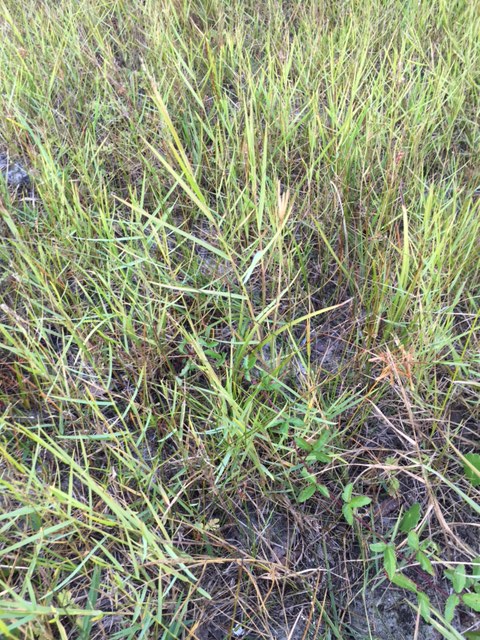
by Rick O'Connor | Feb 26, 2018

Invasive Torpedo Grass. Photo Credit: Rick O’Connor
The topic of invasive species has been with Floridians for decades. Stories of large pythons, exotic lizards, and crazy ants have been coming out of south Florida for years. Brazilian Pepper, Australian Pine, and Melaleuca are just three species of trees that have invaded the Everglades and other south Florida ecosystems.
Though we are having more problems with plants than animals, north Florida is not without their list of invasive problems. Cogongrass, Chinese Tallow, and Japanese Climbing Fern are well established and resource managers are constantly battling these and other invasives. In recent years Lionfish, Cuban Anoles, and a few sightings of Cuban Treefrogs have made their way onto our radar. All of these invasive species are causing either an environmental problem, an economic one, or both and need to be controlled. However, land and resource managers need to know what is out there to be able to do this; and the public can help.
So what can you do?
One of the most frequently used databases is www.EDDMaps.org. Land and resource managers, both public and private, can view this website to see which species are in the area, where they are located, and how common the species is. However, it is only as good as the data provided. Anyone can report an invasive species on EDDMaps.
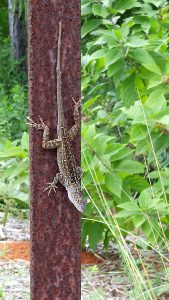
Invasive lizard – the Cuban Anole. Photo Credit; Jerry Patee.
From the home page, you can find a variety of information on invasive species. To report a sighting you will need an account. On the toolbar at the top, you will see REPORT SIGHTINGS. Clicking here will take you through a series of questions. There is some information that you need to have ready. For example, how much area of the property does the invasive plant cover? Estimates are fine but try to be as close as possible. You will also need to know your location. Most phones have a compass on them where the Latitude and Longitude are provided. However, it will need to be converted to decimal point to be posted and there is a conversion tool on the website to do this for you. It is important to report your Longitude as a negative number, or else it will think you are in the eastern hemisphere. Photos are very MUCH desired and, again, your phone photo is good enough. On the home page, you will also see how to download the app “I’ve Got One” which is a quick and easy way to report an invasive species while in the field.
If you are not familiar with many of the invasive species, you can spend some time on the website to learn more. You can also contact your local extension office to discuss species that we know are in the area and those that are nearby. These are good species to be on the watch for and, with your help, we can help keep the website updated.
The extension offices in the Pensacola area will be hosting trainings on invasive species identification and EDDMaps reporting later this year. If interested contact Rick O’Connor (850) 475-5230.
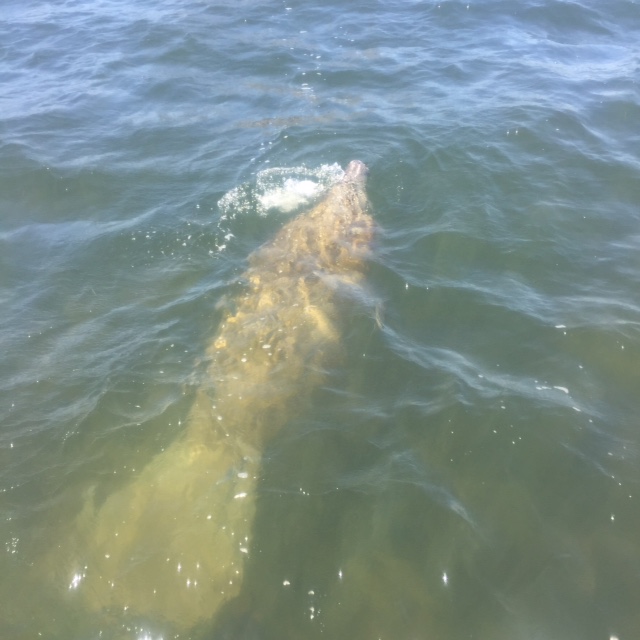
by Rick O'Connor | Feb 16, 2018
As a young boy growing up here in the panhandle, I had heard of this thing called a manatee – but had never seen one. They came more into the light when I was a teenager and becoming interested in marine biology. I was the president of the high school marine biology club and one of our goals was to raise money for a trip to Crystal River to snorkel with them. The Save the Manatee Club originated in that time trying to bring more awareness to the plight of this endangered Floridian and at one point, Jimmy Buffett had led the way.
I had learned a lot about them, found out their original range was from North Carolina south to the Caribbean and the entire Gulf of Mexico, but were now down to about 1000 animals and those were found in Florida. Eventually I did get to see manatees, and have snorkeled with them many times, but still thought of them as a south Florida animal – rarely found in the panhandle.
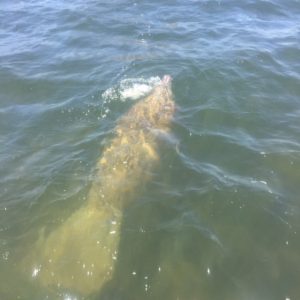
Manatee swimming in Big Lagoon near Pensacola.
Photo: Marsha Stanton
Then the recent news report – two dead manatees in the last two weeks. One washed ashore in Okaloosa county and the other in Escambia. Probably victims of the recent cold fronts. It is not unheard of finding manatees in the panhandle in recent years. I recall since the 1990’s a manatee seen in Bayou Texar in Pensacola. In another year, one was seen near Ft. Pickens. My son worked at a local marina and saw at least one a year there. There have been so many seen in the Mobile Bay area that Dauphin Island Sea Lab now has a Manatee Watch program. There are about 40 individuals that now visit Wakulla Springs. In addition, this summer there were two separate groups living in the Pensacola area. One group was residing near Gulf Breeze and a second group of about eight animals was frequently seen near Perdido Key. These once rare animals in the panhandle are now being found each year, and sometimes in groups.
What is going on?
Why are manatees beginning to visit our area?
Your first hunch would be climate change. Manatees are marine mammals but unlike their dolphin cousins their blubber layer is not as thick and they must seek warm water refuge during the winter months. When water temperatures drop below 67°F, they locate the warm water springs found in central Florida – or move south Florida where the water remains comfortable year round. If they are remaining here, could the average water temperatures have warmed enough for them to make this move?
Along this same line, mangroves are now being found in the panhandle. Both red and black mangroves have been found growing in local estuaries. In the Apalachicola area there have been quite a few located. In the western panhandle there a few individuals here and there. Further west they are found on the islands of Mississippi and have been in the Chandeleurs for many years now. Later this spring Florida Sea Grant will be conducting surveys in each county to see where these tropical trees may be growing.
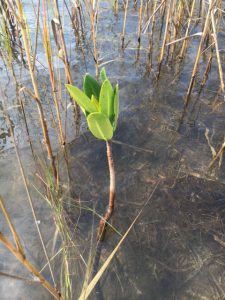
A small red mangrove growing in Big Lagoon near Pensacola FL
Photo: Rick O’Connor
And most recently are sightings of snook, a south Florida fish that have, though rare, been seen in the northern Gulf of Mexico. No doubt this Januarys hard freezes probably killed the mangroves that were here, and probably the two manatees washed ashore recently, but it will be an interesting time to see what other tropical species begin their slow migration northward. If it does happen, what will that mean? How will these changes impact local ecosystems? At this point, I am not sure if it will happen or, if it does, how fast – but it will be interesting.














